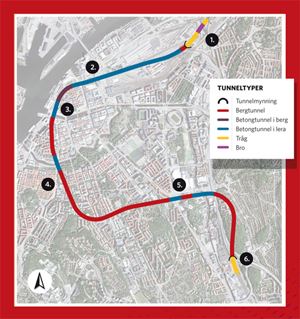
The stations and the tunnel
The West Link gives Gothenburg three new underground stations situated in central locations. The railway tunnel is six kilometers and goes through both rock and soil beneath the city.
The West Link is an eight kilometer long double track railway, including a six kilometer railway tunnel, underneath the city of Gothenburg. With the West Link, Gothenburg central will acquire a new underground station in the northern part of the Nils Ericson Terminal. Two completely new stations will also be available at Haga and Korsvägen. The Railway Study demonstrates that this alternative best fulfils the project´s primary objective of contributing to sustainable growth in both Gothenburg region and the country as a whole.
The West Link will give a total of 100 000 residents and 130 000 workers walking or biking distance to a commuter station in central Gothenburg.
Station Centralen


Gothenburg Central is crowded with both people and trains. Today, all trains that arrive to the station have to depart the same way they came in. The new underground station Centralen will let commuter and regional trains pass through the city, which creates space for more rail commuters who can travel faster, easier and with fewer transfers. The tunnel placement and design of the station has been adapted to the urban development plans. The escalator or elevator takes you directly from the station up to the central parts of Gothenburg.
Station Haga


The station in Haga will play a major role in the development of the western parts of Gothenburg, which belong to future urban development project. The new train stations in the city can reduce the pressure on the Central Station, at the same time as travelers conveniently can get closer to their goal. Fewer transfers also provide the ability to comfortably commute longer distances and relieve other public transport systems. The position of the station in Haga gives the western areas of Gothenburg a faster link to the rest of the region.
Station Korsvägen


Korsvägen is an important hub in Gothenburg's public transport network. The World Culture Museum, Universeum, Liseberg amusement park, the Swedish Exhibition Centre, Valhalla and Scandinavium Arena are all located in the event district in connection with the underground station. Many people are on the move in the area. We are looking for solutions to allow the node Korsvägen to work for the citizens, and to ensure that several of the most important tourist destinations are accessible during the construction phase.

The tunnel
The West Link railway connection is in total about eight kilometers long. Around six kilometers of the railway link will be built in a tunnel beneath the city of Gothenburg. Four kilometers of the tunnel go through rock, and we will blast our way through the rock to construct the tunnel. Two kilometers run through soil and dirt. These parts of the tunnel is built by using a cut-and-cover technique. This means that we dig a shaft in the ground, to make room for a tunnel made of concrete. The concrete tunnel is lowered in the shaft and covered.
The citizens are most affected by the parts of the tunnel built in dirt. This because of the open shafts and temporary redirecting of traffic. To limit the impact on the city, the construction work is divided into several segments. As with all major infrastructural projects, we will not be fully able to avoid interference, but we are daily working to find solutions to minimize impacts during construction.